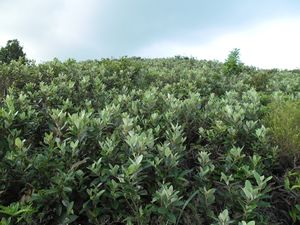Note: This is a project under development. The articles on this wiki are just being initiated and broadly incomplete. You can Help creating new pages.
Difference between revisions of "Rhodomyrtus tomentosa - Rose myrtle"
m (Prabhakar moved page Rhodomyrtus tomentosa to Rose myrtle (Rhodomyrtus tomentosa)) |
m (Prabhakar moved page Rose myrtle (Rhodomyrtus tomentosa) to Rhodomyrtus tomentosa - Rose myrtle) |
(No difference)
| |
Revision as of 10:42, 23 April 2018
Rhodomyrtus tomentosa also known as rose myrtle, is a flowering plant in the family Myrtaceae, native to southern and southeastern Asia, from India, east to southern China, Hong Kong, Taiwan and the Philippines, and south to Malaysia and Sulawesi. It grows in coasts, natural forest, riparian zones, wetlands, moist and wet forests, bog margins, from sea level up to 2400 m elevation.
Contents
Description
Rhodomyrtus tomentosa is an evergreen shrub growing up to 4 m (12 feet) tall. The leaves are opposite, leathery, 5–7 cm long and 2-3.5 cm broad, three-veined from the base, oval, obtuse to sharp pointed at the tip, glossy green above, densely grey or rarely yellowish-hairy beneath, with a wide petiole and an entire margin. The flowers are solitary or in clusters of two or three, 2.5–3 cm diameter, with five petals which are tinged white on the outside with purplish-pink or all pink.
Uses
It has shown promise as a fire retardant species for use in fire breaks in the Himalayas. It is a popular ornamental plant in gardens in tropical and subtropical areas, grown for its abundant flowers and sweet, edible fruit. The fruit can be made into pies and jams, or used in salads. In Phú Quốc, Vietnam, the fruits are used to produce a wine called rượu sim, and are also made into jellies, or freshly canned with syrup for export.
Common name
- English - Rose myrtle
